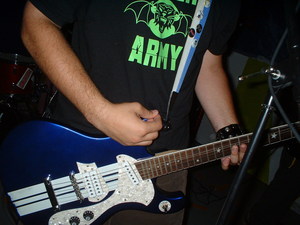It can be the most terrifying moment in a beginning guitarist’s career. You’re jamming on a new piece with your band when suddenly the songwriter turns to you and says, “Okay, I want you to take a solo here.”
This would be great, except that you have no frickin’ clue how to write or play a guitar solo.
I’ve been there, man. I spent my first several years as a “guitarist” playing in pop-punk bands, refusing to solo, refusing to play songs that were more than 3 minutes long, even refusing to play anything other than two-finger power chords unless I was safely tucked away in my bedroom.
Thankfully, I’ve devoted my sham of an existence to developing ways to B.S. people into thinking that I know what I’m doing in all aspects of my life. So it wasn’t long before I came up with a 6-step solution to faking my way through guitar solos. Check it out; you’ll have them all fooled in no time.
1) Just Play the Damn Chords
Stick to the same chord progression that the rhythm guitarist and/or bassist are playing. But don’t strum the chords-instead, pick the individual notes of the chord rhythmically. If you have a fuzz, delay, or modulation effect handy, stomp on it; it’ll help your sweet “solo” stand out in the mix by providing some contrast between your part and the stuff going on with the other instruments.
Of course this method is going to sound a little more interesting and “real” if you try experimenting with different variations of the chords instead of mimicking exactly what the other guy is playing. If you have no idea what I mean by “different variations of the chords” just try this: use the same chords, but play them a whole octave higher up the neck (i.e., pretend that the twelfth fret is the nut.)
Another simple variation on this same theme that can give you pretty cool results is to play the chord progression twice as fast as the rest of your band. Note that I don’t mean this figuratively (“play super-fast, dude!”); I mean that you should literally play the entire chord progression twice in the time it takes for your band to go through it once. Let’s say you’re soloing over a verse part, and in this particular song a verse consists of going through the same chord progression four times; you may be able to go through the same chord progression eight times at double-speed as the foundation for your solo.
As a disclaimer, this particular method totally sounds stupid with certain chord progressions and in no way am I responsible when somebody throws a beer bottle at your head.
2) Memorize Patterns
Want to know a secret? You don’t need to memorize scales to play cool solos. Just memorize patterns. Play around and come up with a few simple melodies that you think might sound cool as part of a solo-they only need to consist of about 3 or 4 notes. Then turn on the radio and try to play along by moving up and down the neck and transposing your melody until it sounds correct-like you’re actually playing along with whatever’s on the radio. This is a magical event in every young boy’s life, and it’s what experts call “playing in key.”
And if you’re saying, “But when I turned on the radio, Rush Limbaugh was on. How am I supposed to play in key with that?” then you need to quit being a smartass before I break your face.
You may think I’m full of crap when I say that a solo can be made up of just 3 or 4 notes (and I don’t blame you; after all, this entire guide is based on lying to people about how good you are at the guitar) but I swear it’s true. A 3-note solo probably won’t be a great solo, but it will at least be presentable and, most importantly, easy to play. For an example, check out The Neverland Rancheros on MySpace (http://www.myspace.com/theneverlandrancheros) and listen to the song “She Was a Bitch”. Listen to the solo that starts around 2:07. There are a few little flourishes, but the whole thing is essentially four notes. I’m not saying it’s awesome; I’m saying it’s a good trick, and I think it’s more than good enough when you consider that no note is ever more than 2 frets away from the note before it.
If you want to practice pattern-based soloing, try this quick exercise. Have a friend play a simple G, C, G, D chord progression. While he plays it, “solo” the following tab over and over again.
e – – – – – – – – – – – – –
B – – – – – – – – – – – – –
G – – – – – -3 – – – – -3-
D – – 5 – – – – – – – – – –
A – – – – – – – – 5 – – – –
E – – – – – – – – – – – – –
Okay, it doesn’t sound that cool, but it’s easy to play and you get the basic idea of how it could be used as part of a solo, right?
3) Bend Notes
This one is super easy and super-effective. When you play a note, just pull down on the string so it’s all like “WHREEEEEEEEEOOOOWWWW!” Amazingly, something this stupid really makes your melodies sound way more like “real” solos. Don’t believe me? Add a little note-bending action to the tab exercise from step 2, specifically concentrating on bending the crap out of the G (D-string, fret 5) note.
4) Make Dumbass Noises
For me, the best thing about soloing is that you can play absolutely anything you want as long as you play it fast, loud, and with confidence.
While I don’t recommend writing a solo that is entirely comprised of weird noises, there is always room for pick scrapes, slides, feedback, and really high out-of-key notes played super fast. If you have a high-gain (e.g., metal) setup, you can even try holding your guitar up to your face and screaming into your pickups. Seriously.
When it comes to kickass guitar noises, pinch harmonics are the undisputable pinnacle; they instantly turn any crappy old melody into an off-the-wall solo. Unfortunately, pinch harmonics are really more of a skill than a weird noise, and I can’t teach you how to do them properly, as I just kind of started making them on accident one day.
5) When in Doubt, Overkill is Killer
Q: When is it appropriate to have flanger, delay, fuzz, and reverb effects all turned on at the same time?
A: When you’re the jackass trying to convince people that you know how to play guitar!
Yes, it’s true that most so-called “musicians” will be able to tell when a hack (i.e., me or you) is trying to cover up crappy skills with wicked effects, but who cares? The true test of a solo’s greatness is whether or not the fat drunk girl in the corner keeps dancing with that lamp, not what some 60-year-old white guy in a blues band has to say about it.
6) Act Cool
A guitar solo is 10% music and 90% attitude. This is the last and most important rule. It can really be applied to all aspects of rock, but it holds particular truth when it comes to guitar solos. No matter how many times you screw a solo up, never look like you screwed it up-never admit, even to yourself, that you screwed it up. Become an egotistical jerk. Decide right now that you are awesome at guitar and never let anybody tell you otherwise. Get some leather pants and a cool haircut. Big sunglasses are good too. Spit on your bass player on stage. Hell, start wearing makeup if you feel like it: nobody can mess with you now, for you are a great swindler of men; you have become a certifiable god of rock in six easy steps.
Now go forth and rock! And please send money when you sign your big record deal. I mean I could even use a dollar or something, seriously…



